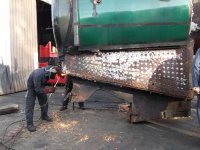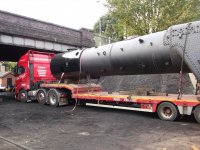Chuffer
CCCUK Member
I can bore you with loads more pics as we pull the rest of it apart if you like ?I do love seeing the innards of a steam loco. Wonderful machines.
Here we are gas cutting the ashpan off from the bottom of the firebox to allow the boiler to be sat on the ground . The hinged flaps at the bottom of both of the hoppers are opened by levers from the cab to control the amount of primary air drawn in under the grate to control combustion . They are also opened to enable all the ash to be raked out when the loco is over a pit to clean the firebox out . A filthy and unpleasant job , believe me as done it many many ties .


